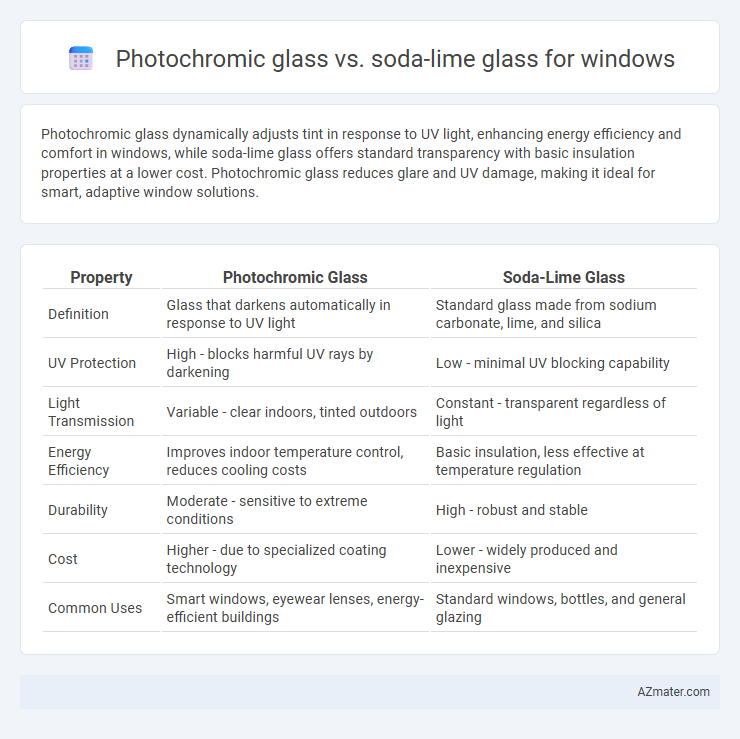Photochromic glass dynamically adjusts tint in response to UV light, enhancing energy efficiency and comfort in windows, while soda-lime glass offers standard transparency with basic insulation properties at a lower cost. Photochromic glass reduces glare and UV damage, making it ideal for smart, adaptive window solutions.
Table of Comparison
| Property | Photochromic Glass | Soda-Lime Glass |
|---|---|---|
| Definition | Glass that darkens automatically in response to UV light | Standard glass made from sodium carbonate, lime, and silica |
| UV Protection | High - blocks harmful UV rays by darkening | Low - minimal UV blocking capability |
| Light Transmission | Variable - clear indoors, tinted outdoors | Constant - transparent regardless of light |
| Energy Efficiency | Improves indoor temperature control, reduces cooling costs | Basic insulation, less effective at temperature regulation |
| Durability | Moderate - sensitive to extreme conditions | High - robust and stable |
| Cost | Higher - due to specialized coating technology | Lower - widely produced and inexpensive |
| Common Uses | Smart windows, eyewear lenses, energy-efficient buildings | Standard windows, bottles, and general glazing |
Introduction to Window Glass Technologies
Photochromic glass for windows enhances energy efficiency by automatically adjusting tint in response to sunlight, reducing glare and heat gain. Soda-lime glass, the most common window glass, provides durability and affordability but lacks adaptive light control. Advances in window glass technologies increasingly favor smart materials like photochromic glass to improve indoor comfort and reduce HVAC energy consumption.
What is Photochromic Glass?
Photochromic glass is a specialized type of smart window material that automatically darkens when exposed to sunlight, reducing glare and UV radiation while enhancing energy efficiency. Unlike traditional soda-lime glass, which is the most common and inexpensive glass used in windows but offers no adaptive tinting properties, photochromic glass contains light-sensitive molecules that enable real-time adjustment to changing light conditions. This dynamic functionality makes photochromic glass ideal for improving occupant comfort and reducing cooling costs in both residential and commercial buildings.
Understanding Soda-lime Glass
Soda-lime glass, the most common type of glass used in windows, consists primarily of silica, soda, and lime, offering affordability and ease of manufacturing. Its optical clarity and durability make it suitable for basic glazing but lacks the adaptive light-filtering properties of photochromic glass. Understanding soda-lime glass highlights its role as a conventional, cost-effective material without dynamic tinting capabilities found in advanced photochromic alternatives.
Light Control: Photochromic vs. Soda-lime Glass
Photochromic glass dynamically adjusts its tint in response to sunlight, providing superior light control by reducing glare and blocking harmful UV rays, unlike soda-lime glass which maintains a constant transparency. Soda-lime glass, commonly used for standard windows, offers minimal light modulation, allowing maximum light transmission but no protection against intense solar radiation. For environments requiring adaptive light management and energy efficiency, photochromic glass delivers enhanced comfort and reduced cooling costs by automatically modulating indoor lighting conditions.
Energy Efficiency and Insulation Properties
Photochromic glass dynamically adjusts tint in response to sunlight, significantly reducing solar heat gain and improving energy efficiency by lowering cooling costs. Soda-lime glass, though widely used for windows due to its affordability, lacks adaptive properties and offers minimal insulation against heat transfer. The superior thermal regulation of photochromic glass enhances indoor comfort and reduces reliance on HVAC systems, making it a more sustainable choice for energy-efficient buildings.
Durability and Lifespan Comparison
Photochromic glass exhibits superior durability compared to soda-lime glass due to its advanced chemical coatings that resist scratches and UV degradation over time. The lifespan of photochromic glass typically ranges from 10 to 15 years with consistent performance, whereas soda-lime glass can last over 20 years but lacks the protective properties against environmental wear. Choosing photochromic glass for windows enhances long-term functionality by combining durability with adaptive light filtering, whereas soda-lime glass prioritizes basic structural integrity without dynamic light control.
Cost Analysis: Affordable Choice for Windows
Photochromic glass typically costs more than soda-lime glass due to its advanced light-reactive technology, which enables automatic tinting that enhances energy efficiency and reduces glare. Soda-lime glass remains the most affordable option for windows, making it popular in standard residential and commercial construction due to its low production costs and widespread availability. For budget-conscious projects, soda-lime glass offers a cost-effective solution, while photochromic glass provides long-term savings through energy efficiency despite higher upfront expenses.
Safety and UV Protection Features
Photochromic glass offers superior safety by automatically darkening in response to sunlight, reducing glare and preventing eye strain, while its UV protection effectively blocks up to 99% of harmful ultraviolet rays, minimizing interior fading and skin damage. Soda-lime glass is more prone to breakage and provides minimal UV protection, allowing harmful rays to penetrate windows, increasing risks of interior damage and health issues. The advanced UV blocking and adaptive tinting properties of photochromic glass make it a safer and more protective choice for window applications compared to traditional soda-lime glass.
Aesthetic Appeal and Design Flexibility
Photochromic glass offers dynamic aesthetic appeal by changing tint based on sunlight exposure, providing both functional shading and modern design versatility in windows. Soda-lime glass features a traditional clear appearance with limited design flexibility but remains cost-effective for standard window applications. The adaptability of photochromic glass enhances architectural creativity and user comfort, making it ideal for innovative building designs.
Choosing the Right Glass for Your Windows
Photochromic glass adapts to changing light conditions by darkening in sunlight, enhancing energy efficiency and indoor comfort, while soda-lime glass offers affordability and standard clarity but lacks dynamic light control. Choosing the right glass for your windows depends on factors like climate, energy savings goals, and budget constraints, with photochromic glass suitable for environments with high solar exposure. Soda-lime glass remains a cost-effective option for basic window applications where advanced light modulation is unnecessary.

Infographic: Photochromic glass vs Soda-lime glass for Window
 azmater.com
azmater.com